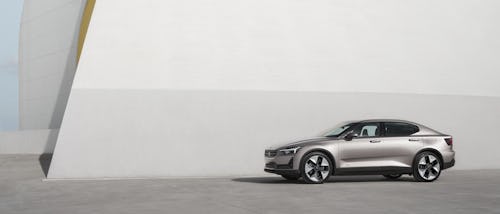
Though EV startup Polestar is already planning the Polestar 5, it’s still making consistent improvements to its current-gen model, the Polestar 2. Today the company announced a number of slight, but notable changes to the Polestar 2, including increased use of the blockchain for tracking production materials.
Polestar has been working with blockchain company Circulator for about a year now to provide transparency around the shipping of minerals needed for the production of its vehicles. The cobalt used in Polestar 2 batteries was the first material tracked in this manner; now Polestar will be tracking its shipments of mica via the blockchain, too.
“Product optimization programs are common in the car industry, but we are taking an extended approach at Polestar, combining these with CO2e reduction programs as well,” said Fredrika Klarén, head of sustainability, in a statement.
Though all its cars already run solely on electric power, Polestar wants to go a step further and eliminate all its carbon emissions by 2030.
Blockchain what? —
Polestar’s press release doesn’t do much to help us understand how, exactly, the blockchain is helping it take better control of its carbon emissions, but the basic premise here is accountability.
When data is written to a blockchain, it may as well have been written in stone. (Hence the “non-fungible” in NFTs.) By committing its supply chain decisions to the blockchain, Polestar holds itself accountable for every sourcing and shipping decision it makes.
Precious minerals are some of the most difficult aspects of EVs to source and, therefore, are that much more important to source with care. Right now Polestar is tracking its mica and cobalt; eventually, it hopes to add its sourcing of manganese, graphite, and lithium to the blockchain as well.

Better sourcing —
Speaking of sourcing: Polestar also announced today that it will begin using low-carbon aluminum — produced using renewable energy — in its tires, rather than more traditional aluminum. That program is still in pilot mode right now. The company expects that, by the second half of 2022, this change will result in a 600 kg CO2e reduction per Polestar 2.
And upgrades —
Sustainability goals aside, the Polestar 2 is also getting some upgrades that buyers will certainly notice. The vehicle’s battery is being upgraded with improved cell chemistry, giving it an increased capacity of 69kWh. The new cell chemistry also allows for faster charging and a longer driving range — up to about 295 miles, now.
Other updates available for the new Polestar 2 include: two new exterior colors, new wheel designs, new interior leather options, a removable sunshade for the glass roof, an improved heat pump, and better cabin filters.








